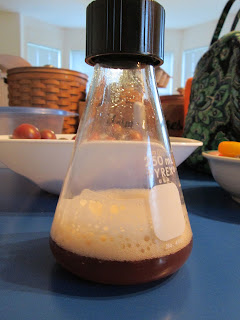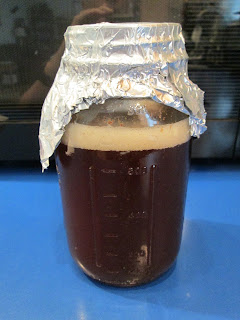The long Labor Day weekend provided a rare (and relaxed) brew day with no other chores or distraction to pull me away. And with low humidity, cooler temperatures and no wind, it was the perfect opportunity to run off a batch of my standard house pale ale out in the garage. I'm completely out of home brew right now and I hope to use these fall weekends to get my stocks back up before winter. I'm still doing some tweaks to my house pale recipe and the QA on the next two batches should get me to a final SOP for this recipe. This is basically the same brew that won first place in the ale category at the local competition back in the spring. But I'm still adjusting the color, bitterness and ABV so I can finally certify this as the house standard.
View of the yeast seed stock at high krausen. This is generally what I'm looking for two days after pulling a freezer vial (in this case the Wyeast Labs #1007 German ale strain) to about 50 mls of 1X sterile wort. I really like #1007 because it is clean. behaves well under standard cellar temperatures and flocculates well. There are lots of other pale ale strains out there but I'm reluctant to change when it comes to the house standard. Also for pales there are lots of ingredients to tweak and having a rock steady yeast strain makes the process a whole lot easier.
The full pitch (~800 ml). The seed is added to sterile wort the night before brew day. By late afternoon of brew day, it is almost at high krausen and ready to pitch. This assures that I'm seeing vigorous fermentation by the next morning. I've recently converted over to mason jars as my standard large volume culture vessels as I no longer have access to an autoclave or one liter screw cap bottles from the lab. Jars are ubiquitous and much easier to handle in the pressure cooker (autoclave) and home lab setting. I also can decant off the trub much easier.
My standard garage nano-brewery set up. Except for maybe having the space for a dedicated nano-brewery in the basement, this is the easiest and most efficient way to go. All of the heat and odor stays out of the house and I have ready access to garden hoses for the cooling coil. I generally have plenty of cinder block and blue stone slabs to adjust heights and give a firm foundation for what turns out to be gallons of potentially scalding liquids. The only down side is having to do this on a very windy day and the increased risk for contamination.
Cooking the rice adjunct. I use plain white rice as my major adjunct as it imparts hardly any flavor and helps boost the ABV. Before use, it needs to be ground in a blender and cooked to fully gelatinize the starch granules thus making them subject to invertases from the pale malt. I generally try to keep with the Reinheitsgebot as much as possible but I also prefer a bit more ABV and this allows me to reach that without increasing the overall grain bill.
One of the joys of garage brewing is using the current weather conditions to make your life easier. Here, the mash tun is getting a slight temperature boost out in the sun and on the hot pavement. This is the protein rest stage and the temperature was dropping a bit. No sense on firing up the burner it you don't have to.
The full mash at the strike temperature for starch conversion. I use a fairly simple step mash. But as you can see I'm just about at the limit for this grain bill and could use a slightly larger tun. One has to be very careful under these conditions of maximum capacity.
Just beginning the full boil. I prefer to add my bittering hops in a hop bag as it makes things much easier when draining off. All that's left at this point is a 90 minute boil, rapid chill with the immersion coil chiller and into the fermenter we go with the pitched yeast.








No comments:
Post a Comment